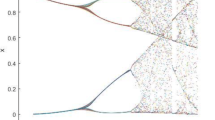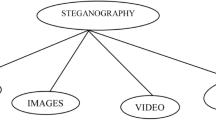Abstract
This work investigates the effectiveness of wavelet packets in dynamic secret key generation (DSKG) for physical layer security (PLS). Preprocessing channel coefficients before quantization is highly essential in DSKG, as noisy measurements on direct quantization produces distinct keys at the transmitter and receiver. Secret keys generated will be having high key disagreement. The performance of different wavelets namely, Daubechies, Symlet and Coiflet, of orders 3 and 5, are studied using Spearman correlation coefficient, bit disagreement rate and NIST randomness tests. NIST tests are evaluated for different bit sequence lengths and as an outcome of the experiment, the best performing wavelet is identified. Further, the proposed work is compared with an existing scheme. It is inferred that, along with maintaining higher correlation coefficient, wavelet packet based DSKG scheme ensures an enhancement in PLS.

Similar content being viewed by others
References
Boubiche, D. E., Athmani, S., Boubiche, S., & Toral-Cruz, H. (2020). Cybersecurity issues in wireless sensor networks: Current challenges and solutions. Wireless Personal Communications, 117(1), 177–213. https://doi.org/10.1007/s11277-020-07213-5.
Jana, S., Premnath, S. N., Clark, M., Kasera, S. K., Patwari, N., & Krishnamurthy, S. V. (2009). On the effectiveness of secret key extraction from wireless signal strength in real environments. In Proceedings of the 15th annual international conference on Mobile computing and networking—MobiCom 09. https://doi.org/10.1145/1614320.1614356
Mukherjee, A., Fakoorian, S. A. A., Huang, J., & Swindlehurst, A. L. (2014). Principles of physical layer security in multiuser wireless networks: A survey. IEEE Communications Surveys & Tutorials, 16(3), 1550–1573. https://doi.org/10.1109/surv.2014.012314.00178.
Pahuja, S., & Jindal, P. (2019). Cooperative communication in physical layer security: Technologies and challenges. Wireless Personal Communications, 108(2), 811–837. https://doi.org/10.1007/s11277-019-06430-x.
Zoli, M., Barreto, A. N., Köpsell, S., Sen, P., & Fettweis, G. (2020). Physical-Layer-Security box: A concept For time-frequency CHANNEL-RECIPROCITY key generation. EURASIP Journal on Wireless Communications and Networking. https://doi.org/10.1186/s13638-020-01712-6.
Shehadeh, Y. E. H., & Hogrefe, D. (2014). A survey on secret key generation mechanisms on the physical layer in wireless networks. Security and Communication Networks, 8(2), 332–341. https://doi.org/10.1002/sec.973.
Deng, C., Deng, H., Liu, X., & Yuan, Y. (2015). Adaptive multi-bit quantization for hashing. Neurocomputing, 151, 319–326. https://doi.org/10.1016/j.neucom.2014.09.033.
Khisti, A. (2016). Secret-key agreement over non-coherent block-fading channels with public discussion. IEEE Transactions on Information Theory, 62(12), 7164–7178. https://doi.org/10.1109/tit.2016.2618861.
Bennett, C. H., Brassard, G., & Robert, J.-M. (1988). Privacy amplification by public discussion. SIAM Journal on Computing, 17(2), 210–229. https://doi.org/10.1137/0217014.
Wu, Y., Khisti, A., Xiao, C., Caire, G., Wong, K.-K., & Gao, X. (2018). A survey of physical layer security techniques for 5G wireless networks and challenges ahead. IEEE Journal on Selected Areas in Communications, 36(4), 679–695. https://doi.org/10.1109/jsac.2018.2825560.
Keshava, N., & Moura, J. (1999). Matching wavelet packets to Gaussian random processes. IEEE Transactions on Signal Processing, 47(6), 1604–1614. https://doi.org/10.1109/78.765130.
Donoho, D. (1995). De-noising by soft-thresholding. IEEE Transactions on Information Theory, 41(3), 613–627. https://doi.org/10.1109/18.382009.
Brechet, L., Lucas, M.-F., Doncarli, C., & Farina, D. (2007). Compression of biomedical signals with mother wavelet optimization and best-basis wavelet packet selection. IEEE Transactions on Biomedical Engineering, 54(12), 2186–2192. https://doi.org/10.1109/tbme.2007.896596.
Blanco-Velasco, M., Cruz-Roldan, F., Godino-Llorente, J. I., & Barner, K. E. (2007). Wavelet packets feasibility study for the design of an ECG compressor. IEEE Transactions on Biomedical Engineering, 54(4), 766–769. https://doi.org/10.1109/tbme.2006.889176.
Zhan, F., & Yao, N. (2017). On the using of discrete wavelet transform for physical layer key generation. Ad Hoc Networks, 64, 22–31. https://doi.org/10.1016/j.adhoc.2017.06.003.
Li, G., Hu, A., Zhang, J., Peng, L., Sun, C., & Cao, D. (2018). High-agreement uncorrelated secret key generation based on principal component analysis preprocessing. IEEE Transactions on Communications, 66(7), 3022–3034. https://doi.org/10.1109/tcomm.2018.2814607.
Margelis, G., Fafoutis, X., Oikonomou, G., Piechocki, R., Tryfonas, T., & Thomas, P. (2017). Physical layer secret-key generation with discreet cosine transform for the Internet of Things. In 2017 IEEE international conference on communications (ICC). https://doi.org/10.1109/icc.2017.7997419
Cheng, L., Zhou, L., Seet, B.-C., Li, W., Ma, D., & Wei, J. (2017). Efficient physical-layer secret key generation and authentication schemes based on wireless channel-phase. Mobile Information Systems. https://doi.org/10.1155/2017/7393526.
Wu, Y., Sun, Y., Zhan, L., & Ji, Y. (2013). Low mismatch key agreement based on wavelet-transform trend and fuzzy vault in body area network. International Journal of Distributed Sensor Networks. https://doi.org/10.1155/2013/912873.
Moara-Nkwe, K., Shi, Q., Lee, G. M., & Eiza, M. H. (2018). A novel physical layer secure key generation and refreshment scheme for wireless sensor networks. IEEE Access, 6, 11374–11387. https://doi.org/10.1109/access.2018.2806423.
Zhang, J., Marshall, A., Woods, R., & Duong, T. Q. (2016). Efficient key generation by exploiting randomness from channel responses of individual OFDM subcarriers. IEEE Transactions on Communications, 64(6), 2578–2588. https://doi.org/10.1109/tcomm.2016.2552165.
Liu, H., Wang, Y., Yang, J., & Chen, Y. (2013). Fast and practical secret key extraction by exploiting channel response. In 2013 Proceedings IEEE INFOCOM. https://doi.org/10.1109/infcom.2013.6567117
Peng, Y., Wang, P., Xiang, W., & Li, Y. (2017). Secret key generation based on estimated channel state information for TDD-OFDM systems over fading channels. IEEE Transactions on Wireless Communications, 16(8), 5176–5186. https://doi.org/10.1109/twc.2017.2706657.
Cheng, L., Li, W., Ma, D., Zhou, L., Zhu, C., & Wei, J. (2016). Towards an effective secret key generation scheme for imperfect channel state information. In 2016 IEEE Trustcom/BigDataSE/ISPA. https://doi.org/10.1109/trustcom.2016.0156
Sarayu, S., Radhakrishnan, J., & Kirthiga, S. (2017). Superimposed pilot based channel estimation for MIMO systems. Advances in Intelligent Systems and Computing Artificial Intelligence and Evolutionary Computations in Engineering Systems. https://doi.org/10.1007/978-981-10-3174-8_11.
Muralidharan, A., Venkateswaran, P., Ajay, S., Prakash, D. A., Arora, M., & Kirthiga, S. (2015). An adaptive threshold method for energy based spectrum sensing in cognitive radio networks. In 2015 international conference on control, instrumentation, communication and computational technologies (ICCICCT). https://doi.org/10.1109/iccicct.2015.7475239
Hong, Y.-W.P., Huang, L.-M., & Li, H.-T. (2017). Vector quantization and clustered key mapping for channel-based secret key generation. IEEE Transactions on Information Forensics and Security, 12(5), 1170–1181. https://doi.org/10.1109/tifs.2017.2656459.
Furqan, H. M., Hamamreh, J. M., & Arslan, H. (2016). Secret key generation using channel quantization with SVD for reciprocal MIMO channels. In 2016 international symposium on wireless communication systems (ISWCS). https://doi.org/10.1109/iswcs.2016.7600974
Aldaghri, N., & Mahdavifar, H. (2020). Physical layer secret key generation in static environments. IEEE Transactions on Information Forensics and Security, 15, 2692–2705. https://doi.org/10.1109/tifs.2020.2974621.
Zeinali, V., & Khaleghi Bizaki, H. (2016). Shared secret key generation protocol in wireless networks based on the phase of mimo fading channels. Wireless Personal Communications, 89(4), 1315–1334. https://doi.org/10.1007/s11277-016-3317-6.
Lin, R., Xu, L., Fang, H., & Huang, C. (2020). Efficient physical layer key generation technique in wireless communications. EURASIP Journal on Wireless Communications and Networking. https://doi.org/10.1186/s13638-019-1634-7.
Kim, S., Ouyang, M., & Zhang, X. (2012). Compute spearman correlation coefficient with Matlab/CUDA. In 2012 IEEE international symposium on signal processing and information technology (ISSPIT). https://doi.org/10.1109/isspit.2012.6621260
Rukhin, A., Sota, J., Nechvatal, J., Smid, M., Barker, E., Leigh, S., & Vo, S. (2000). A statistical test suite for random and pseudorandom number generators for cryptographic applications.https://doi.org/10.6028/nist.sp.800-22.
Yadav, P., & Ramanathan, R. (2017). Dynamic key generation using single threshold multiple level quantization scheme for secure wireless communication. In 2017 International conference on wireless communications, signal processing and networking (WiSPNET). https://doi.org/10.1109/wispnet.2017.8299714
Ramnath, D., Deepak, T., Krishnakumar, K., Vijayaraghavan, S., & Ramanathan, R. (2017). An improved secret key update for multiple intersymbol obfuscation in physical layer security. In 2017 international conference on advances in computing, communications and informatics (ICACCI). https://doi.org/10.1109/icacci.2017.8125839
Kumar, M, S., Ramanathan, R., Jayakumar, M., & Yadav, D, K. (2021). Secret key generation schemes for physical layer security. Defence Science Journal [In press].
Author information
Authors and Affiliations
Corresponding author
Additional information
Publisher's Note
Springer Nature remains neutral with regard to jurisdictional claims in published maps and institutional affiliations.
Rights and permissions
About this article
Cite this article
Kumar, M.S., Ramanathan, R. & Jayakumar, M. An Investigation of Secret Key Generation for Physical Layer Security Using Wavelet Packets. Wireless Pers Commun 120, 701–725 (2021). https://doi.org/10.1007/s11277-021-08485-1
Accepted:
Published:
Issue Date:
DOI: https://doi.org/10.1007/s11277-021-08485-1




